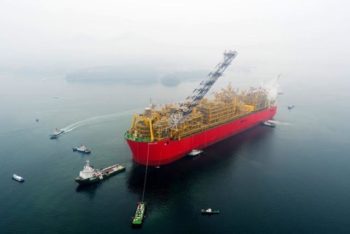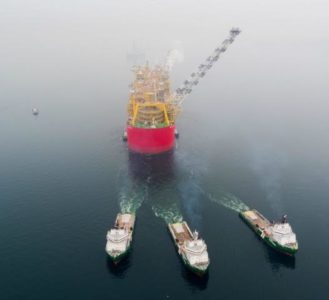
Royal Dutch Shell’s Prelude floating liquefied natural gas (FLNG) facility has set sail from the Samsung Heavy Industries shipyard in South Korea on its 5,800-kilometer journey across the ocean to its new home offshore north-western Australia.
At 488 meters long by 74 meters wide, the 600,000-tonne Prelude FLNG is the largest offshore structure ever built. To put that in perspective, Prelude is longer than four full-size football fields laid end-to-end and it displaces six times as much water as the largest aircraft carrier.
Prelude FLNG departed Geoje, South Korea on Thursday morning under tow by a team of tugboats. The giant facility is destined for the Browse Basin off North West Australia, where it will be moored in about 200km (125 miles) from land at the Prelude gas field for a period of 20 to 25 years. The facility will be used to chill natural gas produced at the field to –162°C (-260°F), shrinking its volume by 600 times so that it can be exported to customers in the form of LNG.
Over the next two decades, Prelude is expected to produce 3.6 million tonnes of liquefied natural gas per year, as well as liquefied petroleum gas (LPG) and condensate, a light oil.

Upon arrival in North West Australia, 16 pre-positioned mooring chains will be connected to Prelude’s 93-meter high turret, permanently securing the facility to the seabed and allowing it to pivot safely with the prevailing current and wind. This ability weathervane means Prelude can ride out even the strongest cyclones without having to disconnect the pipelines that feed gas into the facility from the Prelude field.
The 5,800 kilometer (3,600 miles) tow of the Prelude FLNG involves three tugs, plus one additional escort tug, traveling at a top speed of around five knots. The journey will take the convoy from Geoje harbor and into the East China Sea, across the Korea Straits. The convoy will then travel across the Philippine Sea, past Indonesia, and across the Timor Sea. While in Indonesia, a fifth vessel will meet the convoy to help refuel, replenish supplies and replace the crew. Approximately 160 people will stay on board Prelude during the journey.
“This is the world’s biggest tow and far and away the highlight of my career,” said Captain Alan Stockwel, a 40-year veteran of the marine industry, who is leading a team of tugs.
“The channel has strong currents and Prelude is very large, so you can imagine it’s like a fast car turning a tight corner. The manoeuvres had to be very precise,” says Captain Gerald Seow, Chief Executive of PACC Offshore Services Holdings, the Singapore-based marine services company in charge of the ocean tow.
Once Prelude reaches its final destination, hook-up and commissioning phase is expected to take between 9-12 months.
A sixth towing vessel will join the five boats to keep the facility in place during the hook-up process.
Copyright Ships & Ports Ltd. Permission to use quotations from this article is granted subject to appropriate credit given to www.shipsandports.com.ng as the source.